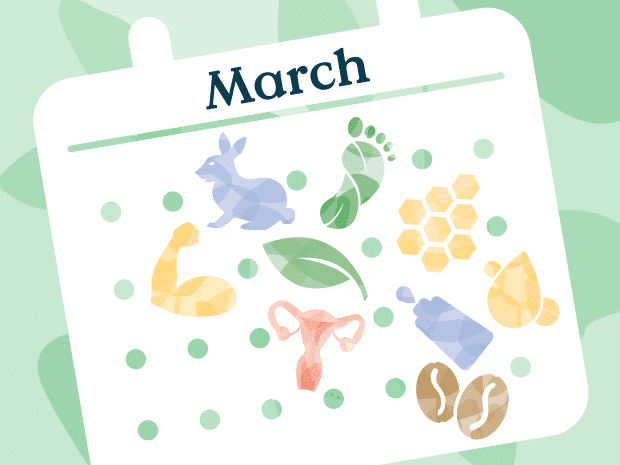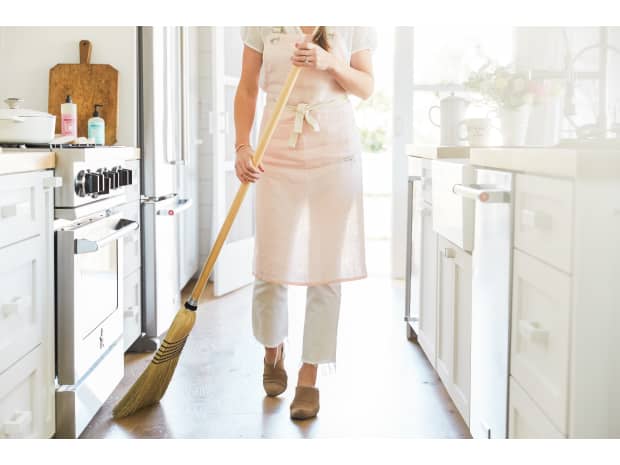
The Germiest Household Items Most People Forget to Clean
The most overlooked things in your home you should be cleaning right now.
Read More


Last Updated: March 8, 2022
Sure, wear your kelly green plaid sweater or olive green corduroys on March 17, but as the world turns green around you over the next 31 days, let this be the month you seek out other ways to green up your life. Here are nine of them.
Around the world, the month of March is most commonly associated with St Patrick’s Day. But there’s more than one way to go green this March instead of wearing a green lapel pin or dancing on the bar in beads for Mardi Gras – March’s other most popular holiday.
In honor of the forgotten days of March, we’ve dug up a few lesser-known holidays that also have opportunities for celebrating by “going green” — but in a way that’ll do the earth (and your body) some real good. You may even save a little spinach, if you know what we mean. While you’re getting ready to celebrate, check out this list of the 28 best green beauty products to look and feel your best.
Every year, Americans alone send 100 billion single-use plastic bags and 50 billion plastic water bottles to the landfill. This World Wildlife Day, why not make a commitment to reducing your plastic use? It’s really pretty easy — and these four super-simple swaps will get you started.
Instead of: plastic straws (half a billion used daily in the U.S.).
Use: metal, bamboo, or glass straws.
Instead of: disposable razors (2 billion sent to the landfill each year).
Use: a reusable razor with disposable blades.
Instead of: disposable toothbrushes (1 billion sent to the landfill each year).
Use: eco-friendly toothbrushes with reusable handles and disposable heads.
Instead of: shampoo and conditioner in bottles.
Use: waterless shampoo & conditioner bars.
National Day of Unplugging is a 24-hour respite from all of the electronic devices that beg for our constant attention and give us blue-light headaches.
To celebrate National Day of Unplugging, unplug devices with wall warts (the big, square plugs like the one on your chargers) and bricks (the large boxes found mid-cord on devices like your laptop) from the wall, and plug them into a smart power strip, which detects when a device is in standby mode and cuts the power to it. Do the same with other energy vampires, like your cable box, gaming system, coffee pot — pretty much anything with a light that stays on.
Happy International Women’s Day, which celebrates women’s achievements and promotes a gender-equal world! But what does gender equality have to do with going green? Well, as it turns out, gender bias and inequality are fundamentally environmental issues that put conservation goals and sustainability at risk worldwide.
So what better day than today to make just one permanent swap that makes you a regular patron of a woman-owned business? You can do it right here at Grove, where we have quite a few favorite women-owned brands. Here are just a few:
Bee’s Wrap
Bee’s Wrap founder Sarah Kaeck made an old tradition new again with her delightful alternative to plastic wrap. Made with organic cotton infused with beeswax, tree resin, and organic jojoba oil, Bee’s Wraps cover any container, creating an air-tight seal and reducing the need for plastic-based food storage solutions.
OSEA
Jenefer and Melissa Palmer are the brains behind OSEA, a beauty brand that creates certified organic, 100% vegan, and cruelty-free skincare products using sustainably sourced, plant-based ingredients. You won’t find any synthetic ingredients in OSEA’s products, which include serums, cleansers, and body oils.
SmartyPits
After her mother was diagnosed with breast cancer, Stacia Guzzo went on the search for an aluminum-free antiperspirant that was convenient and effective. She didn’t find anything, so she created it herself. SmartyPits’ deodorants are free of aluminum, phthalates, parabens, and propylene glycol, and they work like a charm and smell dreamy.
Every elementary school kid knows about Johnny Appleseed, but once you’ve been away from that scene for a while, poor Mr. Appleseed gets lumped in with the likes of Daniel Boone, Paul Bunyan, and John Henry. Need a refresher? In his younger years, John Chapman, born in 1774, worked in a Pennsylvania nursery planting apple trees. Inexplicably, one day he started walking west toward Iowa, planting apple seeds as he went — and coincidentally, where pioneers would later settle. Make like Johnny A. with these three tree-friendly swaps:
Reusable paper towels. Can’t live without your paper towels? Neither can we. These super-sturdy bamboo “paper” towels are absorbent, and when you’re done wiping up a mess, you just rinse it out, reuse it for around a week, and then recycle it.
Tree-free bath tissue. Made from bamboo and sugarcane, tree-free bath tissue is strong, sustainable, and free of chemicals, dyes, and fragrances. It’s safe for all sewer and septic systems and compostable toilets, and did we mention it’s supersoft and absorbent?
Tree-free napkins. These soft 100% bamboo fiber napkins are strong and ultra-absorbent. For every 40 packs of Grove Co. Tree-Free Napkins Grove Collaborative sells, it plants a tree — one million of them by the end of 2022!
The bees and the monarch butterflies are in trouble, and they need our help. Celebrate National Plant a Flower Day by designing a pollinator garden — and planting it, if you’re in the right hardiness zone. A beautiful, colorful pollinator garden packs in the bees, butterflies, hummingbirds, and other critters we need for a healthy ecosystem.
Choose a sunny location, and find out what varieties of milkweed and wildflowers are native to your area. Plant a wide selection of flowers that will bloom at different times during the season, and choose plants that are proven favorites for pollinators in your region. Your local county extension, or this helpful page from the United States Department of Agriculture, can help you choose.
Goddess of Fertility Day is a celebration of fertility, life, love, sex, and rebirth. Today, channel your inner Aphrodite, Isis, or Venus, and fully embrace your femininity in all its messy, complicated, and misunderstood glory. If you’ve been doing your period the same way all these years, maybe it’s time to re-think it. Here are some healthier and greener alternatives to the usual lineup of period products.
Menstrual cups go in like a tampon, but instead of soaking up menstrual fluid, they collect it, holding up to 60 milliliters, compared to a tampon’s five millimeters. Period cups are eco-friendly and reusable, saving you lots of dough over time. Here’s the full low-down on menstrual cups.
Period underwear is amazing. There’s nothing to insert, empty, or dispose of, no unwieldy pads to get bunched up and leak. Nothing but a comfy pair of underpants with ultra-absorbent, leak-proof layers that hold fluids away from your body. Period underwear last up to five years and can replace your pads and tampons. Intrigued? Read more about these miracle garments in our guide to period underwear.
If you prefer doing your period the way you’ve always done it, do your body and the environment a favor by switching to organic tampons. Conventional tampons often contain dyes, chemical fragrances, and pesticides. Certified organic tampons have none of that nonsense, and they have eco-friendly applicators. Learn more about making the swap with our beginner's guide to organic tampons.
One of the best things about March is that it hosts the first day of spring. After the 20th, we’ll see more hours of daylight than darkness from now until the autumnal equinox on September 22. For many, spring triggers a deep desire to rid the home of winter’s physical and psychic grime and clutter. Throw open those windows, and make your spring cleaning checklist. Then, take all of your toxic household cleaners to a hazardous chemical dropoff site, and start the green season with cleaning supplies that won’t pollute the water and poison your air.
Making the switch to natural cleaning products is a huge step toward a healthier home, and it’s an apropos way to go green for spring. Natural, plant-based cleaners are nontoxic, biodegradable, and tough on dirt — not the environment.
Happy National Fragrance Day! Not to burst your bubble, but “fragrance” is a pretty dirty word in pro-health and pro-environment circles. That’s because conventional fragrances in air fresheners, household cleaners, perfumes, and body care products are rife with harmful or toxic volatile organic compounds, or VOCs, including formaldehyde, phthalates, benzene, and toluene. One study of 25 common household products found more than 130 harmful VOCs associated with hormone disruption, respiratory problems, and even certain types of cancer.
Clean home fragrances include all-natural room sprays, naturally scented beeswax and soy candles, and pure essential oils you can diffuse to fill your rooms with irresistible aromas. Clean perfumes are just as heady and complex as synthetics, but they’re formulated with essential oil blends that are healthy for your body and the earth.
When you make a small, simple, eco-friendly change in your daily habits, the effects reverberate. If you’re a daily coffee drinker, celebrate National Joe Day by making your cuppa java more gentle on the environment. Here’s how:

The most overlooked things in your home you should be cleaning right now.

Follow our comprehensive checklist of totally tackle-able tasks to make your place shine.

Our handy guide to everything you need to know to keep you and your family healthy and germ-free.

Our cleaning guide for ovens that are a sticky mess makes it easy to tackle a tough task with natural products.